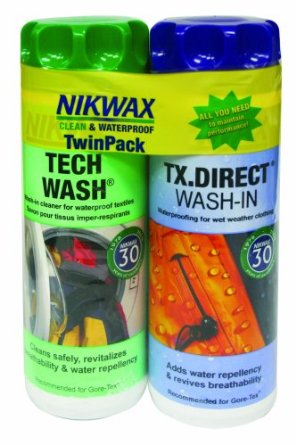How can I dye a Ventile jacket?
How can I dye a Ventile jacket?
Name: Brian
—ADVERTISEMENTS—
Refresh and restore DWR water-repellent finishes on outdoor gear

DWR finishes are incompatible with dyeing. DWR finishes should be applied only after dyeing is completed.
Country or region: UK
Message: I have a Ventile Barbour Jacket in RAF Blue that I would like to dye Black. Can you advise me of the suitability of doing this and the materials I will require to make a success of this? My wife regularly dyes items but is a little cautious regarding this material.
It appears that Ventile fabric is very tightly woven from 100% cotton.
Some of the information I see online fails to mention that there is a water-resistant coating applied to the surface of Ventile fabric, but it's not uncommon for such treatments to go unmentioned. The description of a Ventile Parka at Wiggy's (a manufacturer of outdoor gear) says that it does have a DWR (durable water repellent) finish applied to it. If this is true of your jacket, then you will not be able to dye it. To test it, sprinkle a few drops of water across the fabric. If they do not sink into the fabric, you have a good DWR finish, which will make dyeing impossible, by repelling the dye and preventing it from soaking into the fabric.
Durable Water Repellent finishes are often made with the same sort of fluoropolymers used in making the chemical- and water-resistant finishes of Teflon cookware. You will not be able to remove a DWR finish from clothing. When DWR finishes appear to lose their effectiveness, as the result of dirt, oils, or fabric softener treatments in the laundry, they are actually still in the fabric; their effectiveness will return after the garment is properly cleaned with a product such as Nikwax Tech Wash. After years of wear, when washing no longer restores the water repellency of a DWR finish, it is necessary to renew the finish with a new application, but even then there is likely to be enough remaining of the original finish to prevent good dyeing.
If Ventile fabrics have not been treated with a DWR finish, then they could be dyed by soaking them in warm water (21°C or 70°F) mixed with Procion MX or other fiber reactive dyes, plus soda ash to raise the pH so that the dyes will react with the fabric, and salt to help the dyes approach the fabric in spite of the large amount of water. This could be done in a five- or ten-gallon bucket, or in a washing machine. (See "How can I dye clothing or fabric in the washing machine?".) The very tight weave of the fabric would call for soaking the fabric overnight first with a single drop of a surfactant, such as Synthrapol detergent or the liquid detergent that is used for hand-washing dishes.
Unfortunately, neither this dyeing technique nor any other will work for a garment that has been treated with a DWR finish, as your jacket probably has been.
Posted: Wednesday - December 08, 2010 at 08:08 AM
Follow this blog on twitter here.
Quick Links
- All About Dyes & Dyeing Top -
- Top of this blog -
- FAQ -
- The Dye Forum -
- How to Tie Dye - How to Batik -
- Books - Toys - Plants -
- Top of this blog -
- FAQ -
- The Dye Forum -
- How to Tie Dye - How to Batik -
- Books - Toys - Plants -
More in this category:
- -
Statistics
Total entries in this blog:
Total entries in this category:
Published On: Aug 29, 2012 02:49 PM
Total entries in this category:
Published On: Aug 29, 2012 02:49 PM